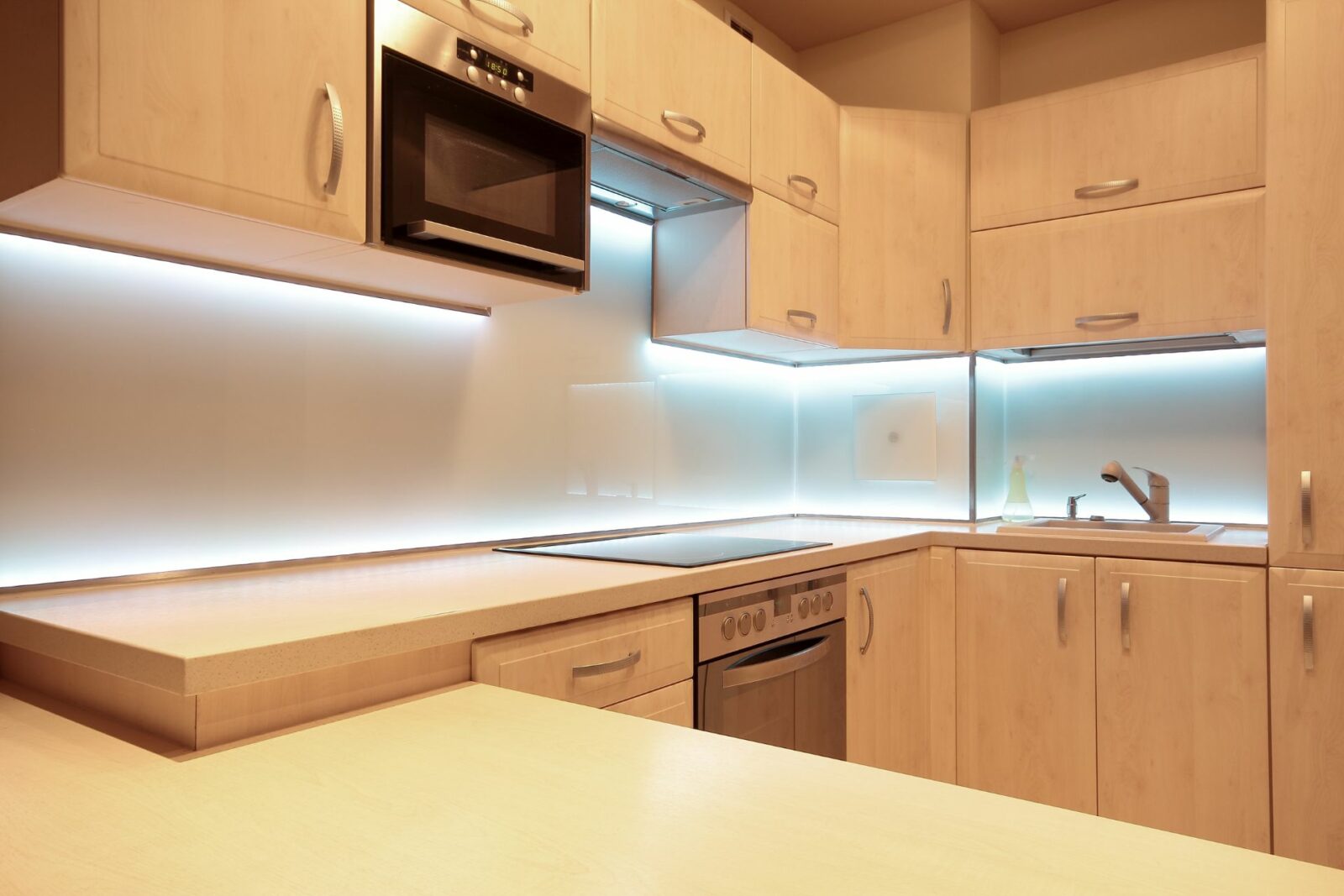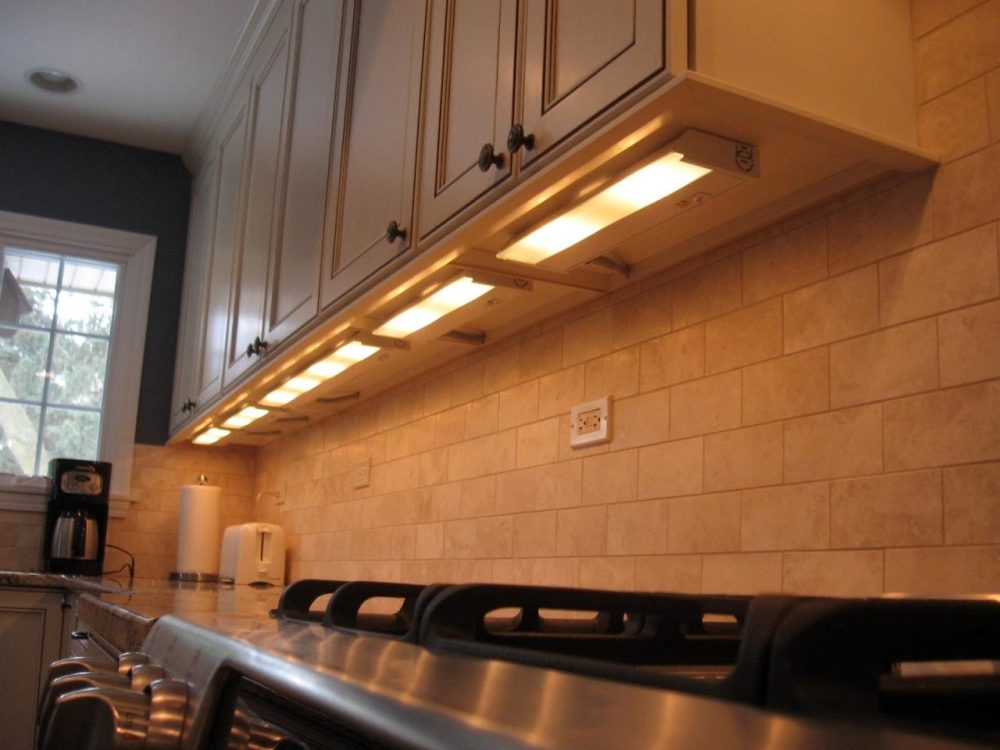Factors Influencing Under-Cabinet LED Lighting Placement: Where To Position Under Cabinet Led Lighting

The ideal placement of under-cabinet LED lighting is determined by a combination of factors, including cabinet depth and size, countertop height, and task lighting needs. Understanding these factors will help you achieve the optimal illumination for your kitchen or workspace.
Cabinet Depth and Size
The depth and size of your cabinets play a significant role in determining the best position for your LED strips. For shallower cabinets, the LED strips can be placed closer to the front edge, providing ample illumination. Deeper cabinets, on the other hand, might require the LED strips to be placed further back to ensure adequate coverage. Consider the following guidelines:
For cabinets less than 12 inches deep, position the LED strips 2-3 inches from the front edge.
For cabinets between 12 and 18 inches deep, place the LED strips 4-6 inches from the front edge.
For cabinets deeper than 18 inches, consider using multiple LED strips or extending the length of the strips to ensure adequate coverage.
Countertop Height
The height of your countertop also influences the optimal placement of under-cabinet lighting. The goal is to ensure the light is directed towards the work surface without creating glare or shadows. A general rule of thumb is to position the LED strips about 1-2 inches below the countertop. This ensures the light is directed downwards and provides even illumination.
For standard countertop heights of 36 inches, position the LED strips 34-35 inches from the floor.
Adjust the placement based on your specific countertop height to achieve optimal illumination.
Task Lighting Needs
The specific task you’ll be performing under the cabinets influences the placement of LED strips. For example, if you frequently prepare food on the countertop, you might want to position the LED strips closer to the front edge for brighter illumination. If you primarily use the countertop for storage, you might prefer a more diffused lighting effect that can be achieved by placing the LED strips further back.
Placement Considerations for Different Types of Under-Cabinet LED Lighting
- Strip Lights: Strip lights are versatile and can be placed in a variety of positions. They are often used along the bottom edge of the cabinet or mounted to the underside of the cabinet shelf. The placement will depend on the desired lighting effect and the depth of the cabinet.
- Puck Lights: Puck lights are small, circular lights that are typically mounted to the underside of the cabinet shelf. They provide focused illumination and are ideal for task lighting. The placement should be strategic to ensure the light is directed towards the work surface.
- Rope Lights: Rope lights are flexible and can be easily bent to conform to the shape of the cabinet. They are often used along the bottom edge of the cabinet or mounted to the underside of the cabinet shelf. The placement should be strategic to ensure the light is directed towards the work surface.
Common Under-Cabinet LED Lighting Placement Techniques

Installing under-cabinet LED lighting involves choosing the best placement technique to achieve the desired illumination and aesthetic. This section explores common placement techniques and their advantages and disadvantages.
Placement Along the Bottom Edge of Cabinets
Installing LED strips along the bottom edge of cabinets is a popular technique that provides a uniform, bright, and functional illumination. This placement maximizes the light’s reach, illuminating the countertop below.
- Direct Mounting: LED strips can be directly mounted to the underside of cabinets using adhesive tape or clips. This method is simple and cost-effective, offering a sleek, unobtrusive appearance.
- Recessed Mounting: For a more integrated look, LED strips can be recessed into the cabinet’s bottom edge. This technique involves creating a groove or channel to house the strips, ensuring a seamless finish. While aesthetically pleasing, recessed mounting requires more effort and might increase installation costs.
Mounting LED Strips Using Adhesive Tape or Clips
Mounting LED strips with adhesive tape or clips is a straightforward method that offers flexibility and ease of installation.
- Clean the Surface: Before mounting the strips, ensure the cabinet’s underside is clean and dry. This ensures proper adhesion and prevents the strips from detaching over time.
- Apply Adhesive Tape: If using adhesive tape, peel off the backing and press the strip firmly against the cabinet’s underside. Ensure the strip is level and aligned with the cabinet’s edge. Use additional tape for added support, especially for longer strips.
- Use Clips: Clips offer a more secure and adjustable mounting solution. Install the clips along the cabinet’s underside, spacing them according to the strip’s length. Slide the strip into the clips, ensuring it is securely fastened.
- Connect the Power Supply: Once the strip is mounted, connect the power supply. Ensure the power supply is properly secured and positioned away from heat sources.
Creating a Layered Lighting Effect
A layered lighting effect involves placing LED strips both under and inside cabinets, creating a multi-dimensional illumination that enhances the space’s ambience and functionality.
- Under-Cabinet Lighting: Provides a general, task-oriented illumination for the countertop below.
- Inside-Cabinet Lighting: Creates a soft, ambient glow within the cabinet, highlighting the contents and adding a touch of warmth.
Comparison of Under-Cabinet LED Lighting Placement Techniques
| Technique | Advantages | Disadvantages |
|---|---|---|
| Bottom Edge Mounting | – Uniform illumination – Simple installation – Cost-effective |
– Less aesthetically pleasing than recessed mounting |
| Recessed Mounting | – Seamless and integrated look – Enhanced aesthetic appeal |
– More complex installation – Higher costs |
| Adhesive Tape Mounting | – Flexible and easy installation – Cost-effective |
– Less secure than clip mounting – May detach over time |
| Clip Mounting | – Secure and adjustable – Durable and long-lasting |
– Slightly more expensive than adhesive tape mounting |
| Layered Lighting | – Multi-dimensional illumination – Enhanced ambience and functionality |
– Requires more components and installation effort |
Tips for Optimizing Under-Cabinet LED Lighting Placement

Proper placement of under-cabinet LED lighting is crucial for achieving the desired illumination and aesthetic appeal in your kitchen. By strategically positioning the lights, you can effectively illuminate your workspace, enhance the overall ambiance, and create a visually stunning kitchen environment.
Minimizing Shadows and Maximizing Light Distribution, Where to position under cabinet led lighting
To ensure optimal illumination and minimize shadows, consider these tips:
- Install LED strips close to the front edge of the cabinet. This placement maximizes light distribution across the countertop and minimizes shadows cast by objects.
- Use multiple light sources. Installing LED strips along the entire length of the cabinet, rather than just a single strip in the middle, provides more uniform lighting and eliminates dark spots.
- Employ diffusers. Diffusers soften the light and create a more even glow, reducing harsh shadows.
- Choose LED strips with a wide beam angle. A wider beam angle, typically 120 degrees or more, distributes light more effectively, minimizing shadows and illuminating a larger area.
Creating Depth and Dimension with LED Strips
LED strips can be used to create a sense of depth and dimension in your kitchen by strategically manipulating the light.
- Install LED strips under the upper cabinets to highlight the lower cabinets. This creates a visual separation between the two levels and emphasizes the lower cabinets.
- Use LED strips with different color temperatures to create visual contrast. For instance, installing warm-white LED strips under the upper cabinets and cool-white LED strips under the lower cabinets can create a distinct visual separation and enhance the sense of depth.
- Utilize dimming capabilities to control the intensity of the light. This allows you to create different moods and ambiances in your kitchen.
Choosing the Right Color Temperature for Under-Cabinet LED Lighting
Color temperature, measured in Kelvin (K), influences the ambiance and appearance of your kitchen.
- Warm-white LED strips (2700-3000K) create a cozy and inviting atmosphere, ideal for creating a relaxing dining experience.
- Neutral-white LED strips (3000-4000K) offer a balanced and bright illumination, suitable for general kitchen tasks and creating a clean and modern feel.
- Cool-white LED strips (4000-5000K) provide a crisp and bright light, enhancing visibility and creating a more energetic and focused environment.
Common Under-Cabinet LED Lighting Placement Mistakes to Avoid
Mistake 1: Installing LED strips too far back under the cabinet, resulting in uneven light distribution and shadows.
Mistake 2: Using only one LED strip in the middle of the cabinet, creating dark spots and inadequate illumination.
Mistake 3: Choosing LED strips with a narrow beam angle, resulting in concentrated light and harsh shadows.
Mistake 4: Using LED strips with a color temperature that does not complement the overall kitchen design and ambiance.
Where to position under cabinet led lighting – Under cabinet LED lighting can be a great way to highlight countertops and create a warm ambiance, but it can also be used to accentuate decorative elements. For example, positioning the lights strategically above a bedroom picture wall art display can create a dramatic and eye-catching effect.
By adjusting the angle and intensity of the lighting, you can control the amount of light that falls on the artwork, highlighting its details and creating a focal point in the room.
When deciding where to position under cabinet LED lighting, consider the specific purpose. For instance, if you want to illuminate a china cabinet, strategically placed lights can enhance the display. For a truly stunning effect, check out this guide on light up china cabinets , which offers tips for showcasing your treasures.
Remember, under cabinet LED lighting can be positioned to highlight specific areas, such as a countertop, or to create a more general ambient glow, depending on your needs.